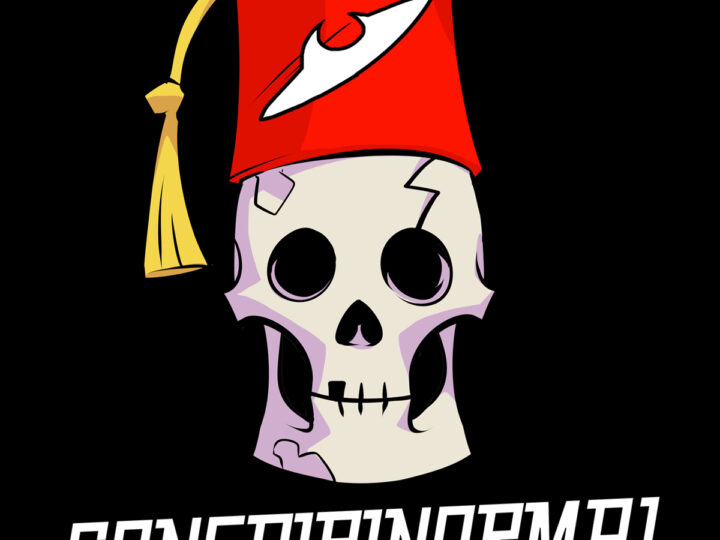
Schismogenesis, Subculture, and the Inevitable Discord Server
Welcome to the latest “Ask Dr. D.,” the Burning Shore’s subscriber-only Q&A column. (As always you may find it more pleasant to read on the web; just click the title above.) Thanks for subscribing, and for your patience—I have nearly completed my LSD blotter book, after which I hope to return to more regular Burning Shore essays.
In the meantime, I have something tasty to offer: an invitation to a Discord server I just set up with some old cronies and members of the Dharmanaut Circle I host once a month. Yes, everyone’s doing it, but they are doing it for a reason! The Discord server is called the Dharmanaut Circle—it’s a way better name for a community than Burning Shore, and a dharmanaut is a fun thing to be, even if sitting on a cushion following your breath can be kinda whatevs.
For those unfamiliar with Discord, it’s a chat platform with group text, voice and video capacity. And because gamers use it a lot, it’s got a fun non-corporate vibe. The server is semi-private, open only to attendees of the Circle, subscribers of the Burning Shore, and friendly freaks with entwining interests. If you are already a Discord user, follow this link to drop in. The invite link expires on 1/25, seven days from today, Tuesday the 18th, or at the waning quarter moon for those of you synced to the heavens. In order to maintain server privacy, the link leads to a threshold waiting room with only basic information channels visible. Please introduce yourself in the threshold channel, and a moderator will then give you access to the main server channels. This may take a few hours, depending on when mods are active.
If you are interested in joining but new to Discord, you will need to install the app on your phone or computer and create an account. A web platform is also available for anyone app-resistant; visit Discord and choose your browser option. Once you are set up with an account and an access point, follow the above link, or use the “join server” function within the platform and enter the link when prompted. Simple video instructions, including how to install the app, create an account (0:00-1:26), and join a server (2:04), can be found on the Tube. More in-depth text instructions on how to use the platform can be found here.
Thanks again for the queries below, which have been edited. I continue to dig back into the archive to answer older questions so don’t give up hope! Or just send me another question here:
— Dr. D.
Today there seems to be a wave of right-wing ideologies and talking points invading sacred spaces. I know that the right has historically been into the occult, but in these times of political divisiveness and strangeness nothing seems safe from the outlandish ideologies infecting people across our country through the means of strong propaganda and mass confusion. I try to hold space for everyone but I find it difficult to associate with people in a sacred setting that hold such outlandish views of the world. Curious about your thoughts. — Matt
Your question is a doozy. I almost left it alone out of fear that it would prove too complex. First, the big picture: we, and I mean all of us, are stuck in a lab-rat labyrinth of rabbit holes and metaverses that is simultaneously out of control and deeply manipulated by all manner of self-serving forces, some of which aren’t even human. (Whether you interpret this in an occult manner or an algorithmic, corporate-person one is your choice.) How to navigate this situation? I don’t know, but I do have a pretty strong suspicion that any time you have a simple and clear idea of who’s at fault you are probably wrong.
More not knowing: I don’t know exactly what sacred spaces you are talking about (yoga studios? ayahuasca circles? groovy churches? holistic healing clinics?) or which right-wing ideologies are riling you up (anti-vax freedom fighters? feverish narratives about satanic pedophile Illuminati Democrats? critiques of campus speech codes?). Because of your emphasis on “outlandish,” I am going to assume you mean more fantastic conspiratorial views rather than, say, less exotic attacks on woke politics.
Here I want to share the exact moment when I realized the wheels were off of the spiritual bus. It was some months before the 2020 election, and I was taking a stroll with a guy who had reached out to me, a smart techie who had done start-up work in Silicon Valley but was now on a spiritual quest. He wore orange robes and sandals, and his calm, focused manner suggested a lot of time spent in meditation, prayer, and study. As we walked, he spoke of his spiritual mentor, an indigenous man who sounded kind of wacky. It became clear that, partly inspired by his teacher, the dude was caught up in a certain “spiritual” way of interpreting the world based on signs, symbols, and myths. He carefully explained how David Bowie’s video for “Black Star” encoded messages about the more-or-less Satanic elite behind the Democratic Party that Trump was combating. Yowza.
In response, I explained that one of the tricky aspects of spiritual or psychedelic practice was how it amplifies your tendency to read the world according to mytho-poetic codes, readings which should be treated more like dreams or allegories than literal truths. Without exactly defending the Democratic Party, something I often find difficult, I suggested that he be equally skeptical about the real forces behind his Knight in Orange Armor, forces that were cynically exploiting legitimate concerns about America’s urban elites for their own harmful agendas. He seemed to agree, then said, as if it were obvious, that even with all that being said it was obviously much better for Trump to win than Biden.
I wasn’t sure how to respond. I have known a few committed Trumpies, but this guy was something else, his position more the result of some kind of infectious magical thinking, a strange system of readings and resonances that seemed geared precisely for seekers like him. My general approach in these situations is not to play partisan, and definitely not to argue, but to try and understand the larger mind-and-machines ecologies that are afoot and that land us—myself included—in certain zones and positions. Our long discussion that day led to more thinking, and I wound up spending a lot of Covid time analyzing QAnon and “conspirituality,” the rise of hardcore conspiracy thinking within alternative spiritual circles. I don’t want to get into that big picture here (check out this and this if you are interested). Instead I want to focus on your more personal question: how to relate to or address people inside the social spaces you consider sacred who are presenting or fomenting seemingly outlandish views?
One approach popular these days is to demonize them: attack these people mercilessly, ridicule and reject their ideas, and keep your spaces as clean of such “infections” as possible. I consider this a path of last resort, though there are sometimes good reasons for it. Without doubt there are in-your-face ideologues who want nothing more than to dominate local discourse communities, and behind them, at least some of the time, are powerful right-wing elites using money and technology to manipulate the information field in order to “infect” naive populations by reframing and absorbing their local beefs and concerns into a larger and more aggressive ideology. In this way, even healthy notions and healthy suspicions—of pharmaceutical corporations, say—can be weaponized by getting folded into broader and more cynical agendas that seek to more drastically shift people’s identity, world-view, and center of emotional resonance. This is how radicalization sometimes happens, or a psychedelic healer like Jake Angeli becomes the Q Shaman.
It seems pretty clear that there was a right-wing or at least anti-vax “influence campaign” specifically directed towards and through alternative medicine, especially towards those zones that involve a holistic approach to the body, since holistic views easily lend themselves to science paranoia and the fear of evil globalist corporations and their Frankenstein technologies. As you point out, esotericism, including holistic healing, has long reflected reactionary sensibilities as well as progressive ones. The occult is no more “yours” than “theirs.”
If you are talking about Q Shaman types, let me suggest that you don’t worry about “holding space” for them but simply ask them questions, curious but penetrating questions, about their sources and suspicions, and about how they get from A to B. If they are willing to play ball, internal contradictions and bald-ass foolishness may well pop up. You’ll also get good practice at managing the heavy emotions that will arise, within and without. But you have to stay on your toes and acknowledge points of commonality—shared values, interpretations of the data, similar feelings. It’s a practice.
Take a page from JC, who asked his disciples to be “as wise as serpents and as harmless as doves.” This is a stance equally prepared to slip traps and to forgive, at once suspicious and accepting of self and the unnerving, potentially threatening other. When you are arguing with a committed ideologue (or parrot), the goal is generally not to change their view or out-yell them but to model the engagement for others who are present, especially those who find something attractive in those views. It’s possible to take on a massive barrage of talking points, even from aggressive and charismatic people, with a calm but razor-sharp attitude of refusal that itself moves the dial. Hint: humor helps. A lot. Don’t let them get your goat, and don’t try to “own” them either. Simply demonstrate your own intelligence, discrimination, courage, and non-reactivity in the face of what might be some seriously odious bullshit. Again it’s a practice, neither fun nor particularly satisfying, but I am assuming you are in those “sacred spaces” to do some real work. If they start yelling or get hostile, well, it’s spiritual warrior time.
And you gotta remember the big picture I described above: we are all in the labyrinth of rabbit holes now. Talking points come through your mouth and mine all the time. We are all targets of ideological capture and self-confirming information silos. A recent personal example: I made the uncomfortable decision to get vaccinated myself, and I did it in a pragmatic, grin-and-bear-it way that wrestled with my own ignorance and my distrust of corporate science. But I did not choose to get onto a bandwagon of slander, hatred, and ridicule directed towards people who choose not to get vaccinated, some of whom are friends and family members. Looking at the mainstream media and the confused messaging of public health bodies today, I sometimes feel like I am being recruited into an anti-anti-vax army that melts down the wide variety of refuseniks into one Paranoid Selfish Idiot cartoon. I don’t like being recruited.
You mention political divisiveness, but a sharper term is the anthropologist Gregory Bateson’s idea of schismogenesis, which sounds like something out of a cyberpunk novel but was hatched in the 1930s. In this process, rivalrous groups mutually intensify their differences while ignoring their commonalities, thereby amping up identities that are in many ways defined against the others. As extreme schismogenesis rages through America, many cannot help but see the other side as inherently evil, or, at best, as mindless dupes of evil ideologies. If I remember the stats right, over half of Republicans think the Democrats are evil fools with the percentage a bit smaller on the blue side of the aisle, but not by much. But regardless of what “side” you are on, schismogenesis is itself being exploited and fomented by media corporations and all manner of interested parties that rely on fear, anxiety, and resentment to organize (or disorganize) human populations and direct their passions. And in an age of social media mobs, AI-driven news bubbles, and networked minds, these interested parties are no longer exactly human.
There are reasons—at once ethical, political, and spiritual-existential—to resist schismogenesis. This doesn’t mean giving up on your principles or not calling bullshit when appropriate. Violent disagreements are sometimes part of reality. But it does mean resisting the splitting process within oneself, especially the temptation to project and disown your shadow—a Jungian malady in which we compound our enemies out of our own mud, and one that is now reaching epidemic proportions. Instead, keep your shadow close, like a red-eyed dog, or a crazy uncle.
And remember that big picture. Yes, outlandish right-wingers do and say X, Y, and even Z. But the real predicament we are in does not lie with the “other side” (including the other sides on your side, maybe the dirt-bag socialists or woke Inquisitors depending on your flavor of left). The predicament exists on the meta level—not the metaverse level (at least not yet), but on a level of system dynamics that can be hard to wrap your head around but is no less real for that: an absurd and wicked hypermediated techno-dystopian hairball that makes it hard to make sense of anything at all (and that some people call the “sense-making crisis”). So one thing to do in your sacred spaces is to practice with the predicament. The goal here is less about winning the war (or the argument) than about not becoming a monster, fool, or knave as you navigate the fog that always accompanies war. It’s about being curious about the collective conundrum we are in, and staying with the trouble that comes: fear, dread, fury, deep sadness. In Zen we say that life itself is the koan—well, here’s your impossible sound of one hand clapping.
If you had a chance to curate an art exhibition with any artist or collection of artists who would you choose and why? — Christopher
On a different day, I might have a more arcane and art-historical answer, probably involving West Coast assemblage artists or visionary egg-tempera painters, but right now I have LSD blotter on my mind. Mark McCloud, who runs the Institute for Illegal Images that is the subject and source for my upcoming book, has mounted a number of blotter shows already, but here are a few pieces and artists I would definitely want in my show.
“Pink Flamingos,” Grandpa, circa 1987
Grandpa was the handle of Shep Mishkin, a gay Jewish artist from the East Coast who made playful and memorable blotters for decades, in San Francisco and for a few years in Amsterdam. He was good friends with medical marijuana activist (and LSD fan) Dennis Peron and lived at the Castro Castle community that Peron set up. There he also palled around with Gilbert Baker, the creator of the now world-famous rainbow flag, whose vision was vouchsafed Baker in a glittery nightclub on acid. Pink Flamingos is the name of a notorious John Waters film, and if that and the leather daddy above aren’t enough proof of San Francisco’s profound gay-acid freak fusion, the meticulous rainbow-flag blotter that Mishkin also made should seal the deal. Grandpa never got busted, and his last blotter before death was a pair of cherubs.
“Tiger,” unknown, circa 1978
Most printed street blotter was either silkscreened or produced with offset lithography. But one of the simplest ways to get images onto blank sheets of blotter was rubber stamps, often picked up from the corner hippie-crap store amidst the beads and bongs. Rubber stamps were generally only used for limited runs by small-scale dealers who wanted an easy way to mark or brand their sheets. With “Tiger,” an unnamed but decidedly big-time Santa Cruz maker used an offset printer to produce his blotters at scale, but created a design that intentionally mimicked the fuzzy informality of a rubber stamp in order to disguise the size of his operation.
“Divine Moments of Trump,” Stella Strzyzowska Guillen, 2019
This is one of my favorite recent examples of “vanity blotter”—illustrated blotters that aren’t intended to carry LSD but to circulate in a collector’s market as the work, at least at times, of identifiable artists. A lot of vanity blotter is regurgitated psychedelic kitsch, but some of it shines mighty. This piece, by the young Miami artist Stella SG, is based on a vision she downloaded from ceremony, and which, as you might imagine, somewhat disturbed and discomforted her. But the visionary artist Alex Grey encouraged her to paint it regardless. “Divine Moments” makes ingenious use of color and playfully riffs on the Peruvian artist and vegetalista Pablo Amaringo’s classic manner of organizing the picture plane to include both visionary and material dimensions. But what I really like is how uncomfortable these totalitarian seekers make us feel: is it bitter irony, or alt-right celebration (thankfully no), or an affirmation of the power of psychedelic medicine to redeem apparently horrible characters, or a bemused comment on the inseparability of the visionary and the political?
I just listened to your Rebel Wisdom podcast episode about the Beatles and I am intrigued to hear more of your thoughts about how there’s no “space” for cultural breakthroughs like we had in the ‘60s, that it’s all now narrowcasting. How’d we get into this jam and how do we get out? Or do we just have to wait patiently like Taoist exiles in the mountains for the time to be right again? — Bill
I have two related ideas here about the relationship between culture and “space” (really, space-time) within technologically mediated society. The first I think is pretty uncontroversial. Part of the reason so many of us were attracted to Get Back was not just that it was an amazing film, but that it allowed people today—suffering through the splintered and algorithmically managed multiplex of media flows that shatters our sense of “consensus reality”—to flashback to a time when a single creative and dynamic band could seize the hearts of so many different people around the world. In other words, part of our Beatles “nostalgia”—a complex term, worthy of nuance and qualified respect—is a longing for the ability of a small group of creators to simultaneously make aesthetic breakthroughs and to act as a magnet or glue powerful enough to focus people emotionally and cognitively in a complex but also fractured society.
That glue, and the loss of it, is no joke. Consider TV news, at least in America. There was an enormous range of political positions in America in the middle of the 1960s, from Illuminati-spooked right-wingers to old-school Reds, from civil rights warriors to acid-gobbling corporate Republicans, from racist southern Democrats to East Coast peaceniks, from drop-out bohemians to science-fiction libertarians. But pretty much everyone watched Walter Cronkite, the anchor on CBS Evening News. Or if they didn’t, they felt his presence. He not only reported the news but did so with an aura of decency that could simulate a center which in some important ways didn’t exist. But that’s the point: virtual or not, this living icon still had the effect of orienting sense-making for multiple sectors of society. When he closed the news with the phrase “and that’s the way it is,” you knew that, whatever was actually happening, and even if what was actually happening was not on the news, there was still a way that “it is.”
That’s why the one beef I had with Rob Sheffield’s otherwise wonderful take on Get Back in Rolling Stone was his comment that the only boring thing about the doc were the interviews with ordinary Londoners on the street. I disagree. I think these chats were exceptionally important, and probably recognized as such by Jackson, precisely because they were mostly boring interviews with ordinary people, not just the charming Apple Scruffs, but also older Londoners who just stumbled into liking the Beatles, maybe because their kids brought the records home, or because they stirred the embers of a fading British pride.
So what was unique about the conditions in those years? There is no way around it: the 1960s was an incredibly dynamic and experimental period in arts and culture. But this ferment also boiled up as a “sweet spot” in the globalization of analog electronic media. Marshall McLuhan described the postwar universe of electronic media as an “acoustic space,” by which he meant that it was a space of resonance, of participation, affect, and contagion rather than rational linear thinking associated with the old Gutenberg galaxy. The Beatles were able to resonate far and wide not just because they were pop geniuses, but because the acoustic space was goldilocks perfect in those years. New technologies—like the multi-track studio, FM long-form radio shows, and LSD—created a zone of innovation that magnified and recirculated the mutations in culture. But the distribution of all this stuff was still analog media, which meant things moved relatively slowly through relatively few channels into relatively unsaturated minds—but still across the planet. So a band like the Beatles was, in effect, able to plunge down its own rabbit hole of pop experimentalism and still come out on Olympus.
The second idea has to do with the difference between subculture and narrowcasting. For all its prosperity, the postwar Western world of the last 75 years has been pretty alienating and terrifying in a lot of ways. One way that folks—and young people in particular, including newly invented “teenagers”—carved out a space for personal passion and human togetherness was through subcultures, modern tribes, and fan culture. By directing your psychic juices through objects of cultural obsession—David Bowie, Star Trek, hot rods—you were able to creatively focus your individual identity while resonating with other niche dwellers. By gathering physically, at least at times, you could form an alternative zone of values and cultural reference—what Trekkers called a “weekend-only world”—that repurposed or “poached” chunks of the culture industry for more intimate, collective, hedonistic, and enchanted ends that were, more or less, “bottom-up” rather than “top down.”
I am thinking here of Mods and Rockers, longboarders, Deadheads, ravers, Pagans, or the early writers of slash fiction—the subgenre of fan fiction that elaborated the homosexual love affairs of nominally straight TV characters, like Kirk and Spock. It’s important not to romanticize these scenes, which could be thuggish and insular and dumb; many of them were more parasitic on the culture industry than their rebel stances acknowledged. But here’s the thing: in a way they were “narrowcasting” themselves, going deeper than the media itself wanted to go into a particular zone or sensibility. And to do that work, subcultures needed free time and unmanaged space to develop organically, both of which were available in the analog margins. While the Grateful Dead were quite conscious of their unique fan base by the early ‘70s, and made decisions to foster and cultivate the heads, the scene mostly developed in its own absurd way for many many years. The Deadhead did not become a widely recognizable identity until the later ‘80s, when the fandom exploded in part because the scene was already dripping with romance, adventure, symbolic richness, and, dare I say, authenticity.
Something happened in the new century, something that involved social media, consumer tracking, urban rents, the triumph of nerd entertainment culture, and our own subjective sense of time and space. Fandom became compressed, more thoroughly manipulated, and more technically organized, even as its deep logic became eviscerated. Today it can feel like being a fan is simply the instantiation of an algorithmic marketing plan—like a sneaky “gotchya” LARP. Major films aimed at a youth market are accompanied by big-money campaigns designed to trigger and coerce fannish desires and intensities, using tricks and tools pulled from social psychology. Yes, inventing fandom was always part of consumer culture, but not to this degree, or with these consequences. Doug Rushkoff made some great documentaries on this, like Generation Like and Merchants of Cool.
So while the Internet has allowed weirdo fans all around the world to get hot and heavy about ever more recherché topics, the frictionless character of the technology collapsed the echoing chambers of McLuhan’s acoustic space—a kind of eviction from resonance. The Internet also sucked libido and magic from the literal physical environments—clubs, coffee houses, snotty record stores—that created the environs for subcultural initiation, adventure, commitment, and risk. Frictionless also means it is hard to stick around, so that fandoms and genres bleed into one another and become less worthy of directed, identity-forming passion. When I taught a course on cultural criticism to undergrad millennials about a decade ago, I was shocked to discover that most of them did not seem to be passionately invested in particular musical preferences, whereas almost everyone I knew in college built their identity around bands and taste. These kids mostly just listened to pop music because, well, there it is.
Humans are terribly creative, and there is lots of great media out there. But the millisecond a fresh trend emerges long enough to be named, it is algorithmically identified, amplified, recirculated—and then more easily abandoned. Just recall the last time you felt a sense of discovery around some odd niche and started to explore: WHAM-O, the bitstreams are in your face with merch, memes, and pushy opportunities to connect and “join the community.” There is no longer time or space for subculture in the old sense. Instead we have narrowcasting.
I totally realize this is grumpy-old-man talk, and you are welcome to dismiss me with an “OK, X’er.” But the stakes are serious. As mentioned, the modern world has been an anxious and alienating place for quite a while, and subcultures provided a kind of neotribal buffer of symbolic collectivity. So when subcultures become ersatz and unsatisfying in the age of narrowcasting, where does one turn for “the tribal”? Maybe you can see where this is going. Could the possibly cataclysmic dynamics of cultural polarization reflect the fact that when more marginalized forms of tribalism collapse, people yearning for intensity and belonging and freedom from the banal turn to Big Angry Frightened Tribes so massive they make their own ontological gravity? The new game is not to escape into a pocket world but to dominate the rest of reality through your narrative. The Mods may have hated the Rockers, but their weapons were smaller, the fighting ground much more localized.
I am not saying that small, creative, and satisfying subcultures don’t or can’t exist now. I am sure they do. I hear about artist collectives or group living arrangements, even among techies, and I feel hopeful. What I am saying is that the subcultures I can see easily, the ones that translate templates based on the old analog scenes into the Internet, have lost something profound in that translation. And if you are wise enough to distrust the sense of belonging provided by the Big Angry Frightened Tribes, where to go?
I think your quip about Taoist sages contains more of the answer than you may suspect. Ideally, the Taoist sage achieved relative freedom by withdrawing from the world and minimizing their needs and retreating to a still bounteous nature. That’s all pretty tough to pull off these days. But here is the thing: they didn’t just do it alone. Taoists also lived in groups, and some even ran medieval Chinese versions of New Age retreat centers. So I like to imagine today’s creative subcultural Taoists are out there somewhere, experimenting with amazing and marvelous and engaged scenes, using new and ancient technologies to re-occupy space and time and community for the glorious fuck-it-all of it. But I don’t know anything about them because they don’t want me to know about them. And that kind of not knowing just makes me smile.
Thanks again for your support, and keep those questions coming!
I hope you enjoyed this flicker of Burning Shore. You can support the publication by forwarding Burning Shore to friends and colleagues, or by dropping an appreciation in my Tip Jar.




